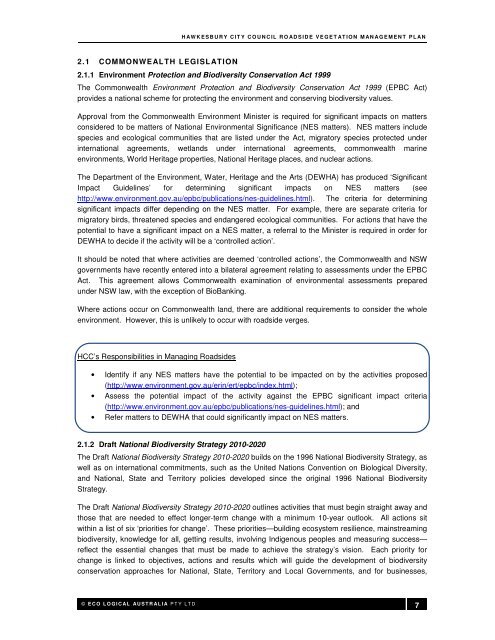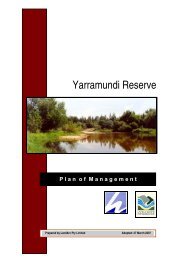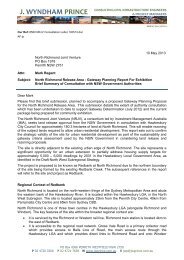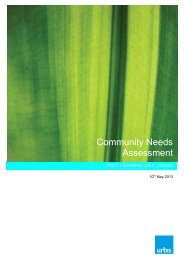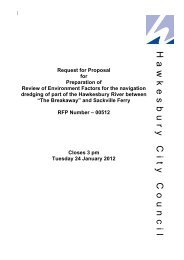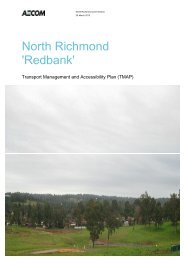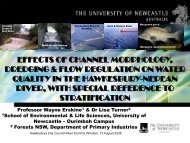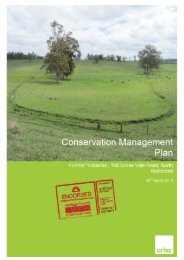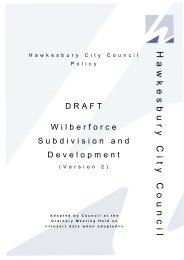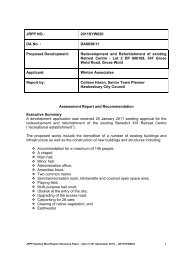Attachment 1 to Item 53 - Roadside Vegetation Management Plan
Attachment 1 to Item 53 - Roadside Vegetation Management Plan
Attachment 1 to Item 53 - Roadside Vegetation Management Plan
Create successful ePaper yourself
Turn your PDF publications into a flip-book with our unique Google optimized e-Paper software.
H AW K E S B U R Y C IT Y C O U N C IL R O AD S ID E V E G E T AT IO N M AN AG E M E N T P L AN<br />
2.1 COMMONWEALTH LEGISLATION<br />
2.1.1 Environment Protection and Biodiversity Conservation Act 1999<br />
The Commonwealth Environment Protection and Biodiversity Conservation Act 1999 (EPBC Act)<br />
provides a national scheme for protecting the environment and conserving biodiversity values.<br />
Approval from the Commonwealth Environment Minister is required for significant impacts on matters<br />
considered <strong>to</strong> be matters of National Environmental Significance (NES matters). NES matters include<br />
species and ecological communities that are listed under the Act, migra<strong>to</strong>ry species protected under<br />
international agreements, wetlands under international agreements, commonwealth marine<br />
environments, World Heritage properties, National Heritage places, and nuclear actions.<br />
The Department of the Environment, Water, Heritage and the Arts (DEWHA) has produced ‘Significant<br />
Impact Guidelines’ for determining significant impacts on NES matters (see<br />
http://www.environment.gov.au/epbc/publications/nes-guidelines.html). The criteria for determining<br />
significant impacts differ depending on the NES matter. For example, there are separate criteria for<br />
migra<strong>to</strong>ry birds, threatened species and endangered ecological communities. For actions that have the<br />
potential <strong>to</strong> have a significant impact on a NES matter, a referral <strong>to</strong> the Minister is required in order for<br />
DEWHA <strong>to</strong> decide if the activity will be a ‘controlled action’.<br />
It should be noted that where activities are deemed ‘controlled actions’, the Commonwealth and NSW<br />
governments have recently entered in<strong>to</strong> a bilateral agreement relating <strong>to</strong> assessments under the EPBC<br />
Act. This agreement allows Commonwealth examination of environmental assessments prepared<br />
under NSW law, with the exception of BioBanking.<br />
Where actions occur on Commonwealth land, there are additional requirements <strong>to</strong> consider the whole<br />
environment. However, this is unlikely <strong>to</strong> occur with roadside verges.<br />
HCC’s Responsibilities in Managing <strong>Roadside</strong>s<br />
• Identify if any NES matters have the potential <strong>to</strong> be impacted on by the activities proposed<br />
(http://www.environment.gov.au/erin/ert/epbc/index.html);<br />
• Assess the potential impact of the activity against the EPBC significant impact criteria<br />
(http://www.environment.gov.au/epbc/publications/nes-guidelines.html); and<br />
• Refer matters <strong>to</strong> DEWHA that could significantly impact on NES matters.<br />
2.1.2 Draft National Biodiversity Strategy 2010-2020<br />
The Draft National Biodiversity Strategy 2010-2020 builds on the 1996 National Biodiversity Strategy, as<br />
well as on international commitments, such as the United Nations Convention on Biological Diversity,<br />
and National, State and Terri<strong>to</strong>ry policies developed since the original 1996 National Biodiversity<br />
Strategy.<br />
The Draft National Biodiversity Strategy 2010-2020 outlines activities that must begin straight away and<br />
those that are needed <strong>to</strong> effect longer-term change with a minimum 10-year outlook. All actions sit<br />
within a list of six ‘priorities for change’. These priorities—building ecosystem resilience, mainstreaming<br />
biodiversity, knowledge for all, getting results, involving Indigenous peoples and measuring success—<br />
reflect the essential changes that must be made <strong>to</strong> achieve the strategy’s vision. Each priority for<br />
change is linked <strong>to</strong> objectives, actions and results which will guide the development of biodiversity<br />
conservation approaches for National, State, Terri<strong>to</strong>ry and Local Governments, and for businesses,<br />
© E C O L O G I C AL AU S T R AL I A P T Y L T D<br />
7


